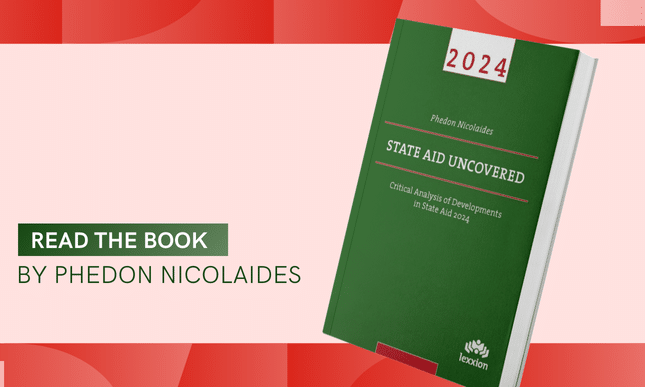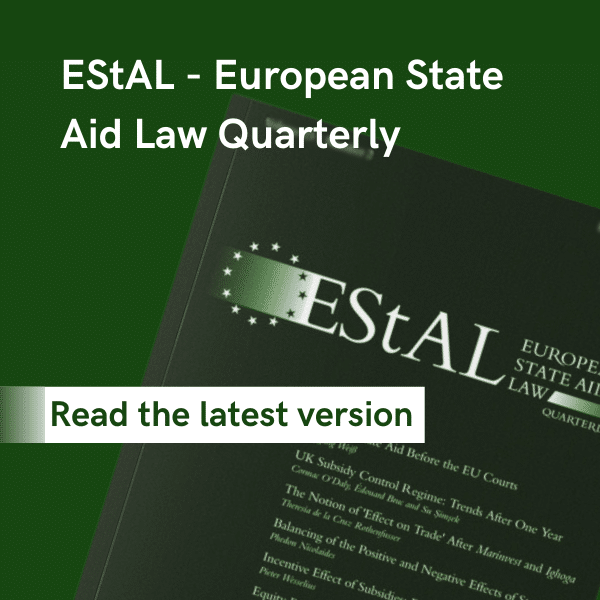
Introduction
A public measure must be selective and satisfy the other criteria of Article 107(1) TFEU in order to be classified as State aid. The detection of selectivity requires a comparative exercise: a comparison of the aid beneficiary or beneficiaries with non-aid beneficiaries. But which non-aid beneficiaries to take into account. The answer is those who are in a similar legal or factual situation, according to the objective of the measure in question. For example, is a measure that supports investment by SMEs selective? SMEs are objectively different from large enterprises because they are smaller! But this measure promotes investment and large enterprises also invest. Yet, the reason that SMEs need investment support is because they do not have the same access to financial markets as large enterprises. Therefore, it appears that there is a good reason for the public support of SMEs. Indeed, it is a good reason, but the intention of public authorities is irrelevant for classifying a measure as State aid. The measure differentiates between SMEs and large enterprises in the support of investment.
On 2 July 2025, in case, T-489/21, Spain v Commission, the General Court responded to a number of arguments advanced by Spain against the findings of Commission that a measure to incentivise the expansion of digital broadcasting in certain Spanish regions was selective.[1]
Spain appealed against Commission decision 2021/2034 concerning State aid granted by Spain for the deployment of digital terrestrial television in remote and less urbanised areas.
This case started about 15 years ago when Spain sought to incentivise companies to invest in digital broadcasting in areas with little demand. After receiving a complaint, the Commission launched a formal investigation which was terminated with decision 2014/489 by which the Commission found that Spain had granted incompatible aid to support the deployment of digital terrestrial television in remote and less urbanised areas.
Spain and a number of broadcasters sought the annulment of decision 2014/489, but the General Court, in case T-461/13, Spain v Commission, and in several other related judgments, dismissed all those actions.
Subsequently, the appeals lodged by Spain and other parties at the Court of Justice [see, for example, case C-81/16 P, Spain v Commission] were rejected. However, one of the appeals [see case C-70/16 P, Communidad Autónoma de Galicia and Retegal v Commission, was upheld by the Court of Justice on the ground that the Commission decision did not explain why the advantage conferred by the Spanish measure was selective. Indeed, that part of the Commission decision was no more than a couple of sentences long and contained no detailed explanation why broadcasting undertakings were in a comparable factual and legal situation in relation to undertakings in other sectors or that undertakings using terrestrial digital technology were different from undertakings using other technologies. The Commission must have thought that it was rather obvious why the measure was selective.
Following the annulment of decision 2014/489, the Commission reopened the case without relaunching the formal investigation procedure and in June 2021, the Commission adopted the contested decision – i.e. decision 2021/2034 – by which it confirmed the selective nature of the measure at issue and found again that Spain had granted incompatible aid that had to be recovered.
Was the Commission required to relaunch the formal investigation procedure?
Spain contended that the Commission erred in law by not initiating afresh the formal investigation procedure.
The General Court first recalled that Article 266 TFEU requires the institution whose act is annulled to take the necessary measures to comply with the relevant judgment. The annulled act immediately becomes null and void.
In this case, the Commission had to correct the mistake identified by the Court of Justice on the issue of selectivity. The Commission was not obliged to re-launch the formal procedure if the information at its disposal was sufficient for that purpose. Consequently, the General Court rejected Spain’s plea. The Court also rejected the Spanish claim that the initial procedure did not provide sufficient evidence on which the Commission could determine the selectivity of the measure in question.
Selectivity
Spain argued that the Commission was wrong to conclude that the measure at hand was selective in the meaning of Article 107(1) TFEU.
First, the General Court recalled that to determine whether a public measure is selective it is first necessary to whether, in the context of a given legal regime, the measure at hand is such as to favour certain undertakings over others, which, in the light of the objective pursued by that measure, are in a comparable factual and legal situation and which are subject to differential treatment that is discriminatory. [paragraph 186 of the judgment]
The requirement of selectivity in Article 107(1) TFEU must be distinguished from the concomitant concept of economic advantage. The advantage must therefore be granted selectively and must be capable of placing certain undertakings in a more favourable situation than others. It must, however, be distinguished according to whether the measure in question is an aid scheme or an individual aid. In the latter case, the identification of the economic advantage allows, in principle, to presume its selectivity. On the other hand, in the case of a scheme, it is necessary to identify whether the measure confers an advantage only to certain undertakings or certain sectors. [para 187]
In order to classify a national measure as selective, the Commission must first identify the reference system, that is to say, the normal regime applicable in the Member State concerned, and then demonstrate that the measure at issue derogates from that reference system, in so far as it differentiates between operators who are, in the light of the objective pursued by that system, in a comparable factual and legal situation. [para 188]
At this point, the General Court cites landmark judgments on tax measures [C-20/15 P, World Duty Free, C-596/19 P, Commission v Hungary]. What the Court does is very interesting. It takes the three-step test for determining the selectivity of tax measures and applies it to a non-tax measure. I suppose the Court signals that that test can be applied to any type of aid measure.
Spain argued that the Commission erred in the identification of the reference system. It ignored the objective of the measure which was to incentivise the switch to digital terrestrial broadcasting in certain areas. By contrast, the Commission considered that the reference system was the whole of the broadcasting sector whose objective was the transmission of digital signals. Accordingly, the Commission took into account all undertakings which offered, or could offer, services extending the coverage of digital broadcasting. The Commission concluded that there was no intrinsic reason for which Spain could justify the ex ante exclusion of platforms, other than land-based platforms.
The General Court agreed with the analysis of the Commission. [paras 198-201]
Next Spain claimed that there was an error in the comparability of the different broadcasters. Since, the Commission found that operators using technologies other than terrestrial technology [e.g. satellite technology] were in a position to offer coverage in the targeted areas, they were in a comparable factual and legal situation to the beneficiary undertakings.
Given the objective of the reference system [i.e. the transmission of digital programmes], the General Court held that the Commission was right to consider that the operators of terrestrial platforms and the operators of satellite platforms were both capable of ensuring that transmission and, therefore, were in a comparable situation. [para 208]
Spain also argued that the aid beneficiaries were compensated for the extra cost and difficulties of broadcasting in the targeted areas. The General Court rejected that argument on the grounds that that the objective of the reference system was not to provide compensation. [paras 223 & 226-228]
Advantage
Spain claimed that the Commission failed to prove that the beneficiary undertakings received an advantage in the meaning of Article 107(1) TFEU. According to Spain, the measure was intended to compensate for structural disadvantages.
The General Court dismissed that claim outright. [para 317] The Court also rejected the argument that the beneficiaries did not obtain an advantage because the amounts which they received were used to purchase equipment the use of which was free of charge for the end user. The fact that the cost of extending the network and the cost of operating and maintaining that network in the targeted areas were free of charge for the end user did not preclude the existence of a competitive advantage for the operators of the terrestrial network, since they were in competition with other platforms in the context of the market for the provision of transmission services of the digital broadcast signal. [paras 318 & 319]
Spain also argued that the beneficiaries received no advantage because they had been selected public contracts. In response the General Court referred to point 89 of the Commission’s Notice on the Notion of Aid according to which the sale or purchase of assets, goods and services that are carried out following a competitive, transparent, non-discriminatory and unconditional tendering procedure are in line with market conditions. In addition, points 93-96 of the Notice explain that the use of public procurement procedures also eliminate advantage, provided they are non-discriminatory, objectively linked to the purpose of the contract and the most economically advantageous offer is chosen. [paras 324 & 325]
In this case, the Commission concluded that the calls for tenders were not technologically neutral, since they excluded satellite network operators. Therefore, they could not be regarded as open and non-discriminatory. [para 328]
Conclusion
Spain also contested the recovery of the aid and failed as well. In the end, the General Court dismissed the appeal in its entirety.
[1] The full text of the judgment in languages other than English can be accessed at:



